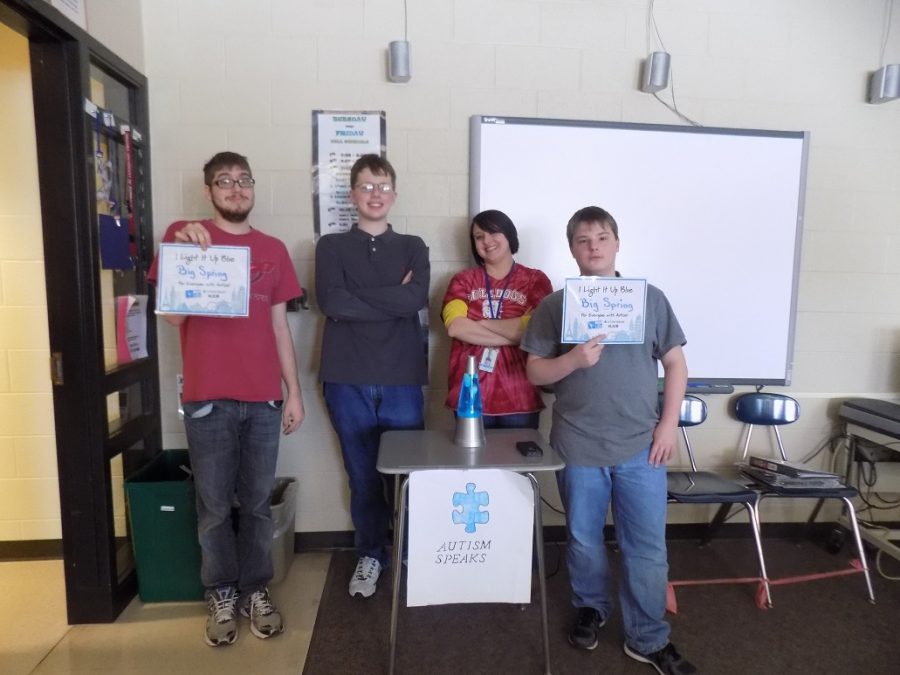Big Spring students celebrate autism awareness
April 26, 2016
Walking into room 313, the colorful posters and bright floor mats are dulled in comparison to the bright blue lava lamp placed at the head of the room. April is national Autism Awareness Month, and here at Big Spring, the autism resource class is ringing the occasion in. Students and teachers alike are celebrating by stringing up blue lights outside the house, wearing their blue “hump day” shirts, or even bringing the party inside by changing their lamp light bulbs to blue. But, what’s even more important than how Big Spring is celebrating autism awareness, are the students and staff in Big Spring that make autism education possible.
Sara Franklin, the autism specialist here at Big Spring, opened up about how she feels about how autism is perceived in modern society. According to Franklin, autism is a an issue that is “rising in prevalence. [Most people] don’t understand what it looks like until they meet someone with it.” In fact, there are many common misconceptions about autism in the modern world. Franklin said that students seem to possess a “lack of intelligence, social incapabilities, [and they’re] not interested in making relationships, but that’s not true.” When autistic students decide to not work in a group, most people assume it is because they want to be left alone, but it is actually just easier for the student to work by themselves than to work with others. Also, students with autism are far from low intelligence; in fact, about half of Franklin’s students are on grade level with their peers. But, Big Spring is definitely a good place for autistic students to be. Franklin said, “We have a welcoming school. Teachers are willing to make changes.” But students and staff at the school also need to remember some important things that Franklin pointed out. “Remember they need things explained more than you expect” and “things we might think are obvious might not [be to them].” But overall, Franklin stresses that it is important to remember that students with autism are just as whole as you and me. “Just because they act differently, they can still have a lot of strengths” Franklin said.
When it comes to autism awareness, Franklin is all in. She decorates her house and changes her indoor light bulbs blue to properly “Light it Up Blue”. Even though light it up blue month is a wonderful event that sheds light on a very important subject, Franklin believes that improvements can still be made. “It gets us all talking about it” Franklin said, but Franklin also shared that there is so much more to Autism than a slight social disorder. “The same 10 bullet points highlighted.” Franklin said. Although these popular points are important, it is also necessary to pay attention to the little known facts and details that often get overlooked. Through all of this Franklin still says that April “get’s people thinking about the tougher problems.”
In the perspective of a student with autism, Noah Eckenrode describes his condition as “a brain disorder.” He then elaborated by adding “It’s kind of like that interest you have is expanded; it’s kind of like getting your first girlfriend and you want to share it with the world.” Girls are great and all, but Eckenrode prefers to keep his interests on dinosaurs and movies. For Autism Awareness Month, Eckenrode set his sights on writing a report about a famous individual with autism, Charles Schulz, the creator of the Peanuts comics. Eckenrode also pointed out that “It’s not a disease. We live very normal, functioning lives. We just need self control.” David Stitt, another student here at Big Spring with autism put the condition into his own words by saying “It’s a disorder that has to deal with emotional and social problems.” with making friends a huge part of that issue. Stitt also added that “I have trouble making friends, but ironically, I have a few.” Through the eyes of Kevin Brobst, autism is “a mental disorder, but could be a physical restraint.” Also, Brobst added that “It can make them socially impaired, but they do have enhanced abilities.” Brobst’s enhanced attributes include video games and coding; he codes JAVA, CSS, Javascript, and many more programs. He also has a soft spot for Narwhals. The only thing these three students have in common is their disability. They are all have different interests, aspirations, and abilities.
According to CDC.gov the chances of having autism today is 1 in 68. So with the increasing number of people dealing with this, it’s important to see continue support in events like Light it up Blue for Autism. Big Spring is a school that has autistic students as well as a great support system through the students and staff, and because of that Light it up Blue for Autism is a success.
